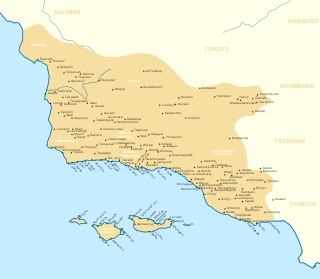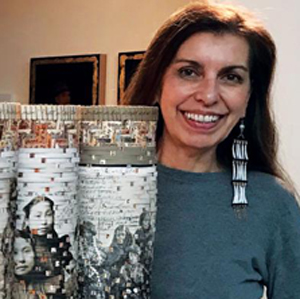Related Research Articles

The Chumash are a Native American people of the central and southern coastal regions of California, in portions of what is now Kern, San Luis Obispo, Santa Barbara, Ventura and Los Angeles counties, extending from Morro Bay in the north to Malibu in the south to Mt Pinos in the east. Their territory includes three of the Channel Islands: Santa Cruz, Santa Rosa, and San Miguel; the smaller island of Anacapa was likely inhabited seasonally due to the lack of a consistent water source.

The Santa Barbara Museum of Natural History is a natural history museum in Santa Barbara, California.

The Autry Museum of the American West is a museum in Los Angeles, California, dedicated to exploring an inclusive history of the American West. Founded in 1988, the museum presents a wide range of exhibitions and public programs, including lectures, film, theater, festivals, family events, and music, and performs scholarship, research, and educational outreach. It attracts about 150,000 visitors annually.

The Burro Flats site is a painted cave site located near Burro Flats, in the Simi Hills of eastern Ventura County, California, United States. The Chumash-style "main panel" and the surrounding 25-acres were listed on the National Register of Historic Places in 1976, with a boundary decrease in 2020. The main panel includes dozens of pictographs in a variety of colors. The cave is in the mountains, near the bi-lingual Chumash/Fernandeno village of Huwam/Jucjauynga. The Burro Flats painted cave and the rest of the former Santa Susana Field Laboratory are not accessible to the public.

The visual arts of the Indigenous peoples of the Americas encompasses the visual artistic practices of the Indigenous peoples of the Americas from ancient times to the present. These include works from South America and North America, which includes Central America and Greenland. The Siberian Yupiit, who have great cultural overlap with Native Alaskan Yupiit, are also included.
Teri Greeves is a Native American beadwork artist, living in Santa Fe, New Mexico. She is enrolled in the Kiowa Indian Tribe of Oklahoma.

Jeffrey A. Gibson is an American Mississippi Choctaw/Cherokee painter and sculptor. He has lived and worked in Brooklyn, New York; Hudson, New York; and Germantown, New York.

Shan Goshorn was an Eastern Band Cherokee artist, who lived in Tulsa, Oklahoma. Her interdisciplinary artwork expresses human rights issues, especially those that affect Native American people today. Goshorn used different media to convey her message, including woven paper baskets, silversmithing, painting, and photography. She is best known for her baskets with Cherokee designs woven with archival paper reproductions of documents, maps, treaties, photographs and other materials that convey both the challenges and triumphs that Native Americans have experienced in the past and are still experiencing today.

Elizabeth Conrad Hickox was a Wiyot master basket weaver and was considered one of the finest basket-weavers of her time. Her baskets differ from other Lower Klamath baskets through her own unique use of shape, technique, color scheme and design.
Barbara Bosworth is an American artist, educator, and photographer. She works primarily with a large-format, 8x10 view camera and focuses on the relationship between humans and nature. Bosworth's works have been included in magazines, journals, books and permanent collections, and shown in solo exhibits nationally and internationally. In 1985, she won a Guggenheim fellowship for her photographic work.

Iva Casuse Honwynum is a Hopi/Navajo artist, social activist, and cultural practitioner. A Native American, Honwynum is best known for her woven baskets and figurative sculpture. Honwynum's most important breakthrough was the development of the pootsaya basket, called "a rare innovation in Hopi basketry". She developed the pootsaya during her 2014 residency at the School for Advanced Research in Santa Fe, New Mexico, having been awarded the Eric and Barbara Dookin Artist Fellowship.
Pat Courtney Gold was a Wasco Native fiber artist and basket weaver from the Columbia River area of Oregon. She graduated with a BA in mathematics and physics from Whitman College and worked as a mathematician-computer specialist before beginning her career in basket weaving. Gold harvested traditional plant fibers to use in her work, including dogbane, cattail, sedge grass, red cedar bark and tree roots. Her pieces often reflected the natural world along the Columbia River, mixing traditional motifs such as condors and sturgeon with contemporary elements like airplanes. Gold also became an environmental and cultural educator, helping to spread knowledge of her ancestral heritage and basketry skills.

Mary Ann Zynsky, better known as Toots Zynsky, is an American glass artist.
Alfred Aguilar, also called Sa Wa Pin, is Tewa Pueblo-American potter, ceramicist, and painter from the San Ildefonso Pueblo tribe. He is known for his coil-built pottery that is carved or painted, his buffalo figurines, and his clay nacimientos.
Rosalie Simbola Aguilar was a Pueblo-American potter from the Picurís tribe. She is known for her black-on-black pottery and for her creation circa 1931 of a technique in which contrasting carved heights were accentuated with glossy or dull coating. Simbola often collaborated with her husband, José Angela Aguilar, who would carve and paint her creations. By the 1930s her pottery was exhibited nationally along with contemporaries like Rose Gonzales, Maria Martinez, Juanita Pena and Tonita Roybal. Simbola's works are in the permanent collection of institutions including the Denver Museum of Natural History.

Jenne Magafan (1916-1952) was an American painter and muralist. During her short-lived career, she became a successful mural painter in the 1930s and early 1940s. She gained national prominence for her work in the New Deal art program. Her twin sister Ethel Magafan was also a muralist.

Linda Yamane is an Rumsien Ohlone artist and historian, and has reconstructed and "almost singlehandedly revived" the Rumsien language, Rumsien basket-making methods, and other Rumsien traditions.
Courtney M. Leonard is a multimedia artist, filmmaker, and activist from the Shinnecock Nation in Long Island, New York. Her work revolves around issues of ecology and Native identity, specifically their intersection with water, which is essential to the Shinnecock. Leonard primarily uses clay and her ceramic artwork has been inspired by the whaling coastal culture of the Shinnecock Nation. She has contributed to the Offshore Art Movement and now focuses on her work, BREACH, which is centered on environmental sustainability.
References
- ↑ "Linda Aguilar | Smithsonian American Art Museum". americanart.si.edu. Retrieved 2024-02-24.
- ↑ "Art Values: Four Pieces of Native Art to Add to Your Collection". Southwest Art. August 2008 – via Ebscohost.
- 1 2 Roberts, Kathleen (April 22, 2011). "WOVEN STRANDS - HORSEHAIR BASKETS ARE THREADED THROUGH CHUMASH WOMAN'S SPIRIT". Albuquerque Journal. p. S1. Retrieved Feb 23, 2024.
- ↑ Linda Aguilar, 2011 Dobkin Fellow . Retrieved 2024-02-24– via YouTube.
- ↑ "Linda Aguilar | School for Advanced Research" . Retrieved 2024-02-24.
- ↑ Madison, Jenna (2014-01-28). "DAM Artist-in-Residence Linda Aguilar Knows Basket making | Denver Art Museum". www.denverartmuseum.org. Retrieved 2024-02-24.
- ↑ "Linda Aguilar". Smithsonian Museum. Retrieved 29 February 2024.
- ↑ "Linda Aguilar". The Autry Museum. Retrieved 29 February 2024.
- ↑ "Works of Linda Aguilar". School for Advanced Research. Retrieved 29 February 2024.